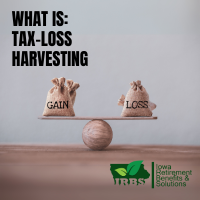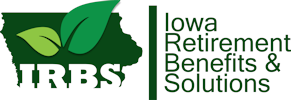Tax Loss Harvesting: A Strategic Guide
Tax Loss Harvesting: A Strategic Guide for Retirees and Pre-Retirees
Posted by Ethan Ball, CRPC
Serving Cedar Rapids, Iowa, and Surrounding Areas.
Tax Loss Harvesting: A Strategic Guide for Retirees and Pre-Retirees
Planning for retirement isn’t just about saving enough—it’s also about preserving what you’ve built. As you near retirement or begin your retirement journey, tax strategies become crucial to protecting your wealth. One often-overlooked but powerful tool is tax loss harvesting—a strategy that can reduce your tax liability and stretch your retirement income further.
In this article, we’ll break down what tax loss harvesting is, why it’s important, and how to implement it effectively. Whether you’re feeling uncertain about the concept or looking for practical tips, this guide is designed to give you both clarity and confidence.
What Is Tax Loss Harvesting?
Tax loss harvesting is a tax strategy that involves selling investments at a loss to offset gains elsewhere in your portfolio. By realizing losses, you can reduce your capital gains taxes and potentially lower your overall taxable income.
For retirees and those nearing retirement, this isn’t just a numbers game—it’s a smart way to preserve more of your hard-earned savings.
Key benefits of tax loss harvesting include:
- Reducing taxable capital gains
- Lowering annual tax bills
- Improving after-tax returns
- Rebalancing your portfolio with less tax impact
Why Tax Loss Harvesting Matters More in Retirement
- You’re Shifting from Accumulation to Distribution
As you approach retirement, your financial strategy transitions from growing your assets to using them wisely. Every dollar saved in taxes is a dollar that can be reinvested or used to support your lifestyle. Tax loss harvesting helps reduce unnecessary tax erosion, giving your portfolio more endurance.
- Your Income Bracket Might Change
Retirees often fall into lower income tax brackets compared to their working years—but not always. Required Minimum Distributions (RMDs), Social Security benefits, and investment income can push you into higher brackets unexpectedly. Tax loss harvesting helps you manage your adjusted gross income (AGI), which can even affect how much tax you pay on Social Security or how much you pay for Medicare premiums.
- Emotional Peace of Mind
Market volatility can create stress—especially if you’re relying on your investments to fund your lifestyle. Tax loss harvesting gives you a proactive strategy, allowing you to take control of a down market instead of simply enduring it. 
When Should Retirees Consider Tax Loss Harvesting?
While this strategy is typically used at the end of the year, opportunities can arise anytime there’s market volatility. You should consider tax loss harvesting when:
- You’ve experienced losses in taxable brokerage accounts
- You’re facing high capital gains in a given year
- You want to rebalance your portfolio without triggering unnecessary taxes
- You’re doing Roth conversions and want to manage your taxable income
Common Emotional Roadblocks to Tax Loss Harvesting
It’s normal to feel uneasy about selling at a loss—after all, no one likes seeing a red number in their portfolio. But it’s important to reframe tax loss harvesting as a tactical move, not a financial defeat.
Emotional Concerns Include:
- “Selling now locks in my losses.”
- “I’m worried about missing out if the market rebounds.”
- “I don’t understand the tax rules and don’t want to make a mistake.”
The reality: Tax loss harvesting is not about giving up on an investment. It’s about using a downturn to your advantage, and often, you can reinvest in similar—but not identical—securities to maintain your exposure.
How to Harvest Losses Without Getting Burned by the Wash Sale Rule
One of the key technical aspects to understand is the wash sale rule. This IRS rule disallows the deduction of a loss if you buy a “substantially identical” security within 30 days before or after the sale.
Smart Tips to Avoid the Wash Sale Rule:
- Replace a sold ETF with one tracking a similar, but not identical, index
- Use an ETFs with different issuer
- Consider rotating between sector funds or factor-based funds
You can also wait the full 30 days to repurchase the original asset, but make sure it aligns with your risk tolerance and portfolio goals.
Tax Loss Harvesting and Retirement Income Planning
For retirees, harvesting losses can also help manage your withdrawal strategy. Here’s how:
- Use harvested losses to offset capital gains from selling appreciated investments when generating income.
- Pair loss harvesting with Roth conversions to stay in a desired tax bracket.
- Reduce your AGI to potentially lower Medicare IRMAA surcharges and taxation on Social Security.
Pro Tip: Work with a financial advisor or tax professional who understands both retirement planning and tax strategy. Coordination is key.
A Simple Example
You have a diversified portfolio that includes a taxable brokerage account, where you invested $40,000 in a technology ETF two years ago. Due to recent market volatility, the ETF is now worth $30,000.
You also have $10,000 in capital gains from selling another investment earlier in the year.
Instead of holding onto the tech ETF and waiting for it to recover, you sell the ETF at a $10,000 loss. This move lets you:
-
Offset the $10,000 in capital gains, so you pays zero taxes on those gains
-
Stay invested by replacing the ETF with a similar (but not identical) fund, maintaining your portfolio’s allocation and growth potential
-
Avoid the wash sale rule by choosing a different ETF with similar exposure
Result: You saves hundreds (possibly thousands) in taxes this year, without changing your long-term investment strategy. And if you didn’t have gains to offset, you could use up to $3,000 of the loss to reduce your taxable income and carry the rest forward to future years.
FAQs About Tax Loss Harvesting in Retirement
Can tax loss harvesting hurt my retirement income?
No—done correctly, it actually improves your after-tax income by minimizing taxes. The key is thoughtful execution.
What types of investments work best for this strategy?
Stocks, and ETFs held in taxable brokerage accounts are ideal. Tax loss harvesting doesn’t apply to retirement accounts like IRAs.
How often should I harvest losses?
Most commonly at year-end, but volatile markets can present opportunities throughout the year. It’s best to review quarterly or during major market downturns.
Final Thoughts: A Personalized Strategy with Powerful Results
Tax loss harvesting is more than a tax hack—it’s a smart, strategic move that can have lasting benefits for retirees and pre-retirees. If done with care, it helps reduce tax burdens, smooth out income fluctuations, and provide a sense of control during uncertain times.
But like all financial strategies, tax loss harvesting is most effective when it’s customized to your unique situation. Your retirement goals, risk tolerance, and income streams all play a role.
If you’re nearing or in retirement and unsure how to begin, don’t go it alone. Speak with a financial advisor who specializes in retirement tax planning. Together, you can turn today’s market losses into tomorrow’s financial wins—without compromising your peace of mind.
Ready to explore how tax loss harvesting fits into your retirement strategy?
Schedule a free consultation today and start making your portfolio work smarter for your future.
Schedule Your Free Financial Strategy Session
Email us at info@iowaretirementsolutions.com
Call us at 319-423-3332
Click here to schedule your free consultation.
Investment advisory services are offered through Fusion Capital Management, an SEC registered investment advisor. The firm only transacts business in states where it is properly registered or is excluded or exempted from registration requirements. SEC registration is not an endorsement of the firm by the commission and does not mean that the advisor has attained a specific level of skill or ability. All investment strategies have the potential for profit or loss.




